The appearance and function of a room can be transformed very quickly and with relative ease when covered with flexible tiles such as vinyl and cork. Be sure to prepare the floor base before proceeding.
MATERIALS REQUIRED
- Chalk
- Adhesive
- Tiles
- Underlay Sheets
TOOLS REQUIRED
- Chalk Line
- Adhesive Applicator
- Scissors
- Steel Square
- Tape or Folding Rule
- Stanley Knife
- Straight Edge
- Vacuum
SAFETY
Always keep tools and materials away from children. Read the instructions before beginning your project.
PREPARE THE BASE FLOOR
Most important: Cover the floor with flooring underlay sheets. Fix and sand in accordance with the manufacturer’s instruction. Thoroughly vacuum the floor before you commence laying tiles. When laying on concrete, it is essential that the concrete surface is level and sound. If there are pronounced dips, hollows or expansion joints, these should be filled and levelled.
There are a number of fillers available for this job. Also, when tiling whole house floors, tiling should not be carried out for three months after pouring concrete. The concrete floor should be dry, that is, has lost its initial dampness. Check this by placing a rubber mat on the concrete overnight. If there is moisture on the surface when you move the mat the next morning, the concrete is too moist for tiling.
Fig. 1. Cover the original floor with flooring underlay sheets.
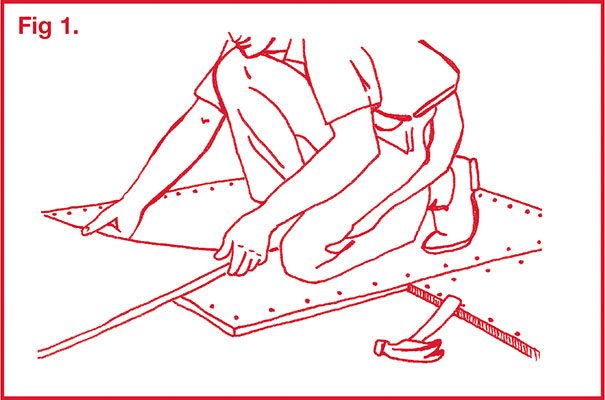 START FROM THE CENTRE OF THE ROOM
START FROM THE CENTRE OF THE ROOM
The first run of floor tiles should start from the centre of the floor, so use these steps to locate the centre of the room:
Locate the centre on each wall and mark that spot. In rooms with offsets or irregularities, ignore the irregularities in the measuring process. (see Fig. 2).
Hold a chalk line at the centre position on the facing wall, as marked and snap it on the floor. The exact centre will be marked at the point where the two lines cross. The example in Fig. 2 shows a room 4.8m x 4.2m with a slight offset.
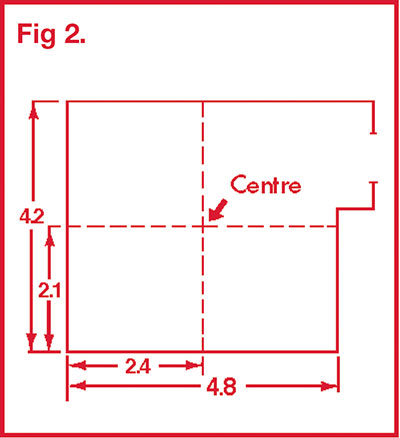 PREPARE THE BASE FLOOR
PREPARE THE BASE FLOOR
Start at the centre point and lay loose tiles along marked lines from the centre, as shown in Fig. 3. You can make adjustments if the centre is not correctly marked.
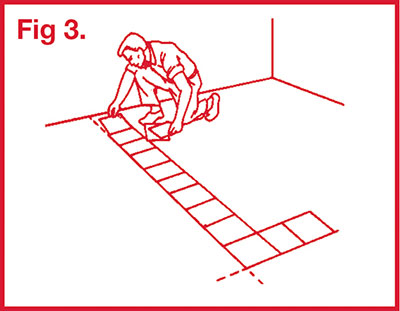
After you have laid a full run of loose tiles along the chalk lines toward each wall (Fig. 3.), measure the remaining distance between the edge of the last tile and the wall on each run.
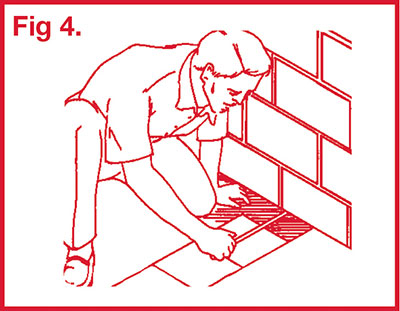
Avoid less than half a tile at the perimeter of the room. Only have full tiles in doorways and entrances.
If the distance between the last tile and the wall is less than 50mm or more than 200mm, you will end up with a narrow cut of the tile (see Fig. 4).
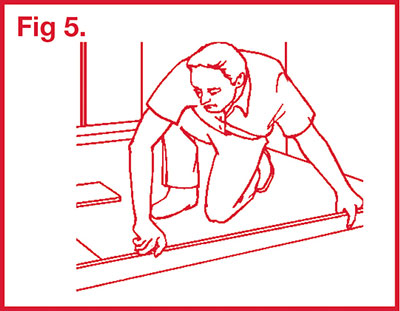
To correct, adjust the centre line that is parallel to the wall by half a tile closer to the wall and re-mark (see Fig. 5).
PLAN THE PATTERN YOU WANT
Tiles and adhesives should be stored indoors for 24 hours prior to laying to acclimatise to normal room temperature. Open tile packets and make small stacks of tiles to speed acclimatisation.
Open all cartons of tiles that are to be used. Conveniently arrange them so you select tiles out of each carton on an alternating basis. This will help to prevent any noticeable colour variation in tiles grouped together.
Next, study the tile patterns and plan your laying pattern. If the tiles are all one colour, plan the pattern according to the grain. You may choose to alternate the run of the patterns, or you may decide to lay the patterns in one direction. Whichever pattern you choose, it is critical to plan in advance.
For tiles of varying colours, plan your design carefully before applying the first tile. This will influence your selection of starting tiles.
APPLY THE TILE CEMENT
The next step - now that you have correctly marked the centre of the room and selected the tile designs and patterns - is applying the adhesive for the tile. If you are using self-sticking tile, skip this section. Read all instructions for the product and follow carefully. Begin by spreading an even coat of adhesive over one-fourth of the floor. Most adhesives are applied with a notched trowel, but some are still applied with a brush or roller.
In most cases, floor tile cement will dry to the proper consistency in about 15 minutes. However, your exact time may vary depending on humidity, temperature, etc. in the room where you are applying the tile. After about 15 minutes, place your thumb onto the cement (see Fig. 6). The cement should feel tacky but should not actually stick to your thumb. If it does stick, allow a little while longer for proper drying. When tacky, but not sticky, the cement is ready for tile application.
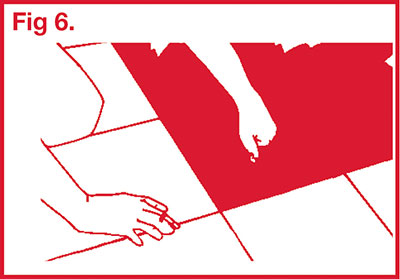 LAY THE FLOOR TILES
LAY THE FLOOR TILES
Start laying the tiles at your markings in the centre of the floor. It is important that the first tile is exactly square with the lines. If the first tile is started wrong, all other tiles will also line up incorrectly.
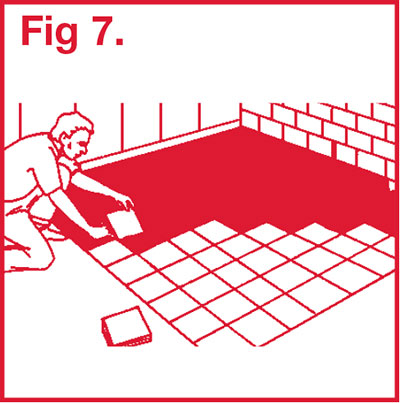
Be sure each tile is butted firmly against the previous one, leaving no gaps. Do not attempt to slide tiles into place. Lay each tile downward firmly into position on the cement.
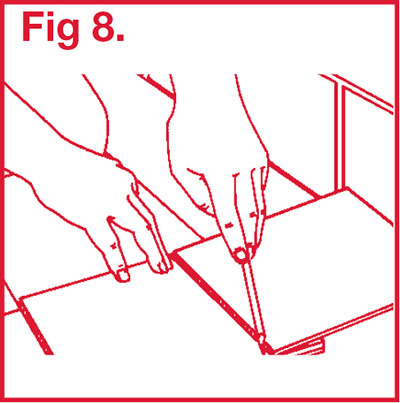
Proceed by laying tiles alternately, according to your plan, toward each wall as illustrated in Fig. 7. This helps to counteract expansion and contraction of the tiles while enhancing the appearance.
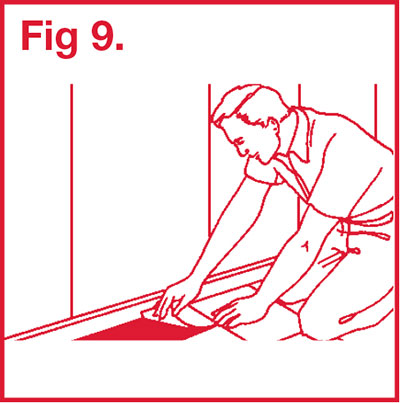
Do not stand or kneel directly on the newly laid tiles. Spread your weight by working on top of a sheet of hardboard laid over the newly laid tiles. To cut the border tile easily and accurately, place a loose tile squarely over the last field tile in the row (see Fig. 8). Then take another tile, butt it against the wall and mark, as illustrated. Cut the tile along the marked line using your Stanley knife. In a cold room, you should warm tiles slightly before cutting. The cut tile will now fit securely into the border space. Be sure this tile is placed face-up and at right angles to the grain of the tile below it. This ensures the correct pattern when it is laid (see Fig. 9). When it becomes necessary to fit tiles around pipes or other obstructions, simply cut a paper pattern and trace the pattern on the tiles. Then cut with Stanley knife (see Fig. 10). Alternatively, use a contour gauge.
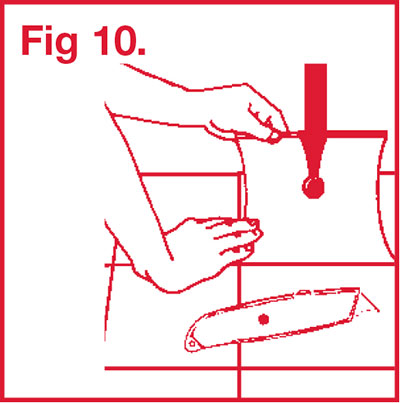 NOTE:
NOTE: If tiles are not pre-polished, finish with a clear treatment in accordance with manufacturer’s instructions. If tiles are pre-polished, do not wash newly laid floor for the first seven days.